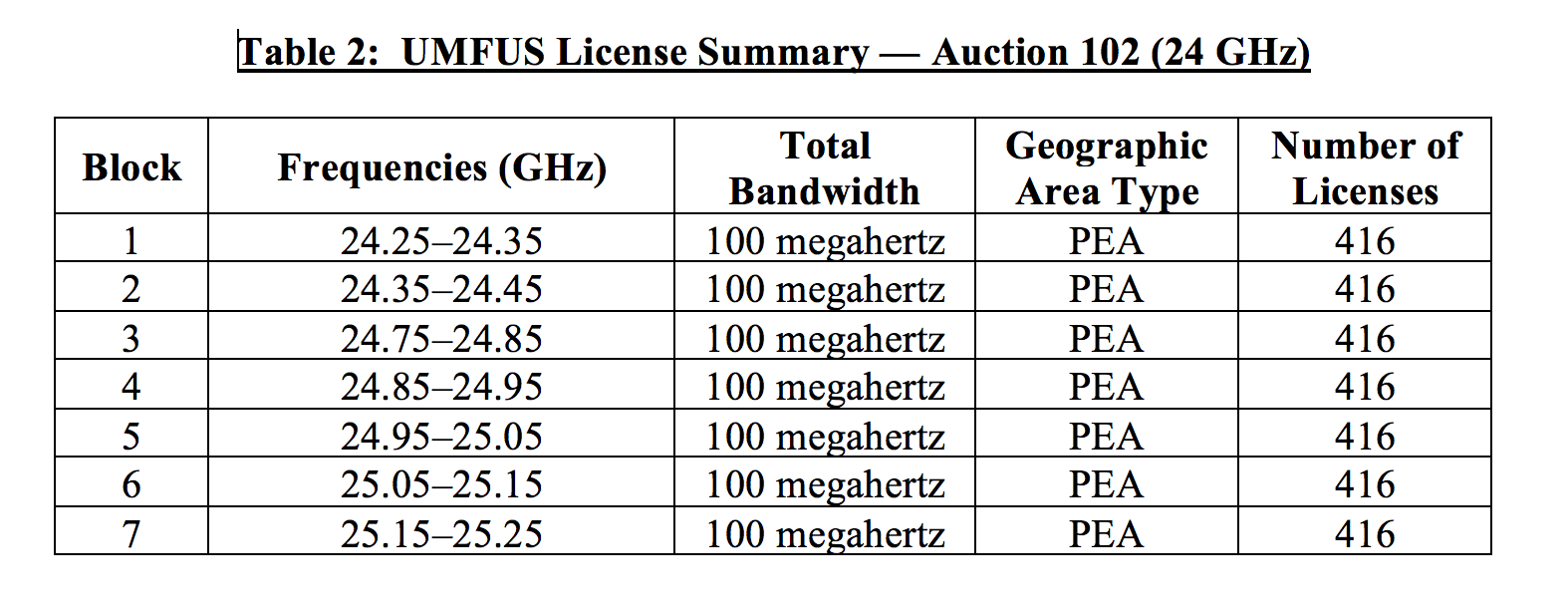U.S. 5G spectrum auctions for 24, 28 GHz bands set to begin in November.
The U.S. Federal Communications Commission gave U.S.’s 5G industry a boost yesterday by announcing its pre-auction process to hold two millimeter wave spectrum auctions for 5G use, starting on November 14th 2018. Portions of the 28 GHz and 24 GHz bands are proposed to be auctioned in two batches, with the second auction beginning after the first is exhausted.
FCC proposed to auction 5,986 licenses in the millimeter wave bands, known as Upper Microwave Flexible Use Service (UMFUS). The 27.5–28.35 GHz (28 GHz) band falls under Auction 101 and 24.25–24.45 and 24.75–25.25 GHz (24 GHz) under Auction 102.
“The FCC had previously released millimeter wave spectrum primarily for 5G testing and trails,” Wayne Lam, IHS Markit analyst Mobile Devices & Networks, told RCR Wireless. “This latest round of spectral offering is likely larger and favors large carriers such as AT&T, Verizon and T-Mobile who have been clammering for more 5G spectrum to be released so that they can commercialize 5G services.”
The FCC action came a few days after U.S. wireless industry group CTIA released a report saying the U.S. was falling behind China in 5G. The group not surprisingly was appreciative. “CTIA applauds the FCC for moving forward with the first high-band spectrum auctions for 5G use,” said CTIA Senior Vice President for Regulatory Affairs Scott Bergmann in a statement. “We look forward to working with the Commission on implementing these critical auctions and on identifying and auctioning additional bands, including mid-band spectrum, to power the wireless networks of the future.”

(Courtesy of U.S. FCC)

Spectrum auction licenses. (Courtesy of FCC)
FCC Commissioner Mignon Clyburn, who announced she was stepping down from the commission, was the most cautious of the commissioners in yesterday’s vote. While all commissioners voted yes, she voted “concurred” after convincing the commission to not propose simultaneous auctions, but to first seek comment instead. She also pointed out it would be more advantageous to start with the 24 GHz auction, and expressed concerns about making the auctions competitive. “We still need input so that our auction procedures are as pro-competitive as possible,” she said in her statement.
Other commissioners were more gung ho. Commissioner Michael O’Rielly called for scheduling auctions for the 37 and 39 GHz bands immediately “and create an auction timetable for the other bands coming down the pipeline. Affected industry needs to know as soon as possible when they will need the resources to participate in what is turning into a necessary ingredient in 5G services.”
Challenges
Millimeter wave does not come without some challenges. The bands are already populated by FSS (fixed-service station) licenses, used by broadcast industry to link to geostationary satellites.
“The challenge for the FCC is how to deal with incumbent license holders in the millimeter wave spectrum. The policy that seems to have been successful has been to create a reverse auction to incentivize existing holders to vacate or move to another swath of spectrum,” said Lam. RCR Wireless reached out to ITU for comment, but it was not available by press time.
FCC created a sharing scheme for 24 and 28 GHz and grandfathered in existing FSS earth stations. In its public notice issued yesterday, the FCC cautions spectrum buyers to be aware of sharing schemes.
The challenge for 5G devices is the inherit limitation of millimeter wave, as IHS Markit’s Lam explains:
At no other previous generation of wireless technology has there been such a reliance on spectrum that attentuates as easily as millimeter wave (i.e. can be interrupted by things such as rain). 5G millimeter wave propagation requires some advanced beam-forming techniques and antenna structures and even then, the user device often have to be within hundreds of feet away from the broadcast/cell tower. The trade-off for these working conditions is of course the order of magnitude increase in bandwidth. However, for any 5G millimeter deployment, coverage in dense urban areas are crucial and would likely be limited to outdoor applications.
On the device side, millimeter 5G presents an unique challenge as we are accustomed to having wide range of movement with our device. In a mmWave 5G application, the simple fact of device orientation (holding it, in relations to cell site) can interrupt the millimeter waves. Therefore, multiple millimeter wave antennas are required and arranged in different orientations to ensure a clean signal.
This is why most 5G networks will be deployed as an NSA (non stand alone) network with 4G LTE serving as the primary fall back of the network.
FCC called for public comment on May 9, 2018 through May 23, 2018.
The post FCC opens comment on two 5G mmWave spectrum auctions appeared first on RCR Wireless News.
